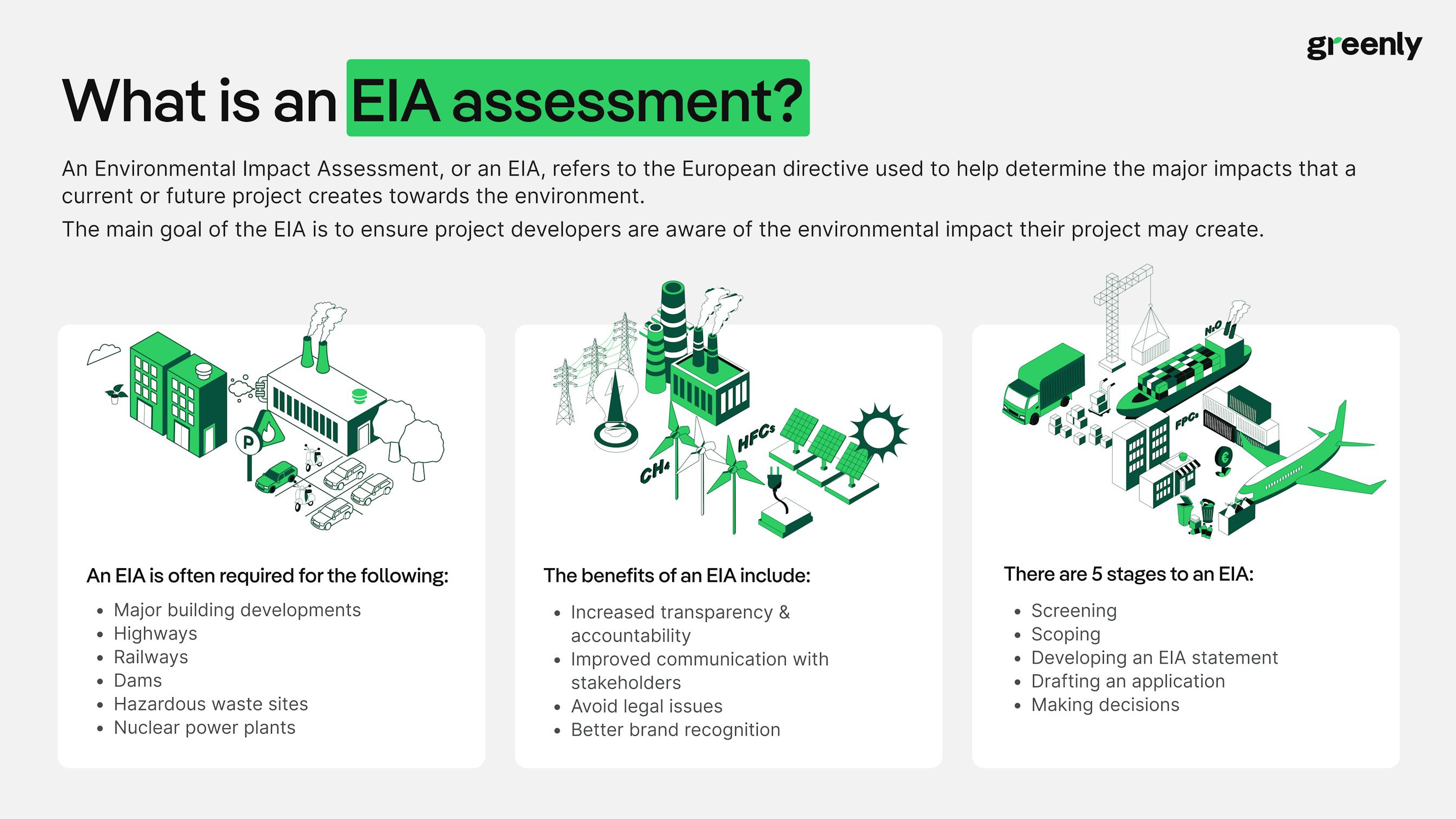
What are the 3 Pillars of Corporate Sustainability?
In this article, we'll explore what the 3 pillars of corporate responsibility are, why they're important, and how businesses can turn them into practical action.
ESG / CSR
Industries



Companies these days face a lot more to lose than just their business, but their respect of other stakeholders for failing to recognise the importance of protecting the environment – which can easily be done with an Environmental Impact Assessment.
Today, many companies and projects seem to get their business up and running before taking environmental measures into consideration – which often results in project leaders scrambling to comply with environmental circumstances at the last minute.
Therefore, an Environmental Impact Assessment can prove to be a game changer for anyone conducting a project in the European Union – as significant environmental effects continue to change town and country planning alike, the EIA process can help those in the EU to improve their decision making process and mitigate their most likely significant environmental effects.
In this article, we’ll explain what an Environmental Impact Assessment is, why it is important in the midst of climate change, and how your project can complete an EIA successfully.
An Environmental Impact Assessment, or an EIA, refers to the European directive used to help determine the major impacts that a current or future project creates towards the environment.
An Environmental Impact Assessment (EIA) can help reveal to companies if their current or upcoming business projects are going to wreak havoc on the environment, asses environmental impacts, influence proposed development, and can present the opportunity for them to course correct this significant effects or environmental factors before following through with the rest of these development projects.
Think about when you determine your monthly budget. Whether the expenses have already been deducted from your bank account or are upcoming expenses – you are planning to see what kind of financial impact this month will have on your monetary reserves. The same goes for an Environmental Impact Assessment, as it is trying to determine the impact it will have on environmental circumstances.


An Environmental Impact Assessment is often required in the EU for the following projects:
Large-scale construction projects consume vast materials and energy, often contributing to habitat loss and carbon emissions.
Encourage vehicle use, leading to increased CO₂ emissions and land fragmentation that disrupts local ecosystems.
While efficient, railway construction can still disturb wildlife habitats and generate high emissions during development.
Alter natural waterways, displace communities, and impact aquatic biodiversity despite renewable energy benefits.
Improper management can contaminate soil and water sources, posing long-term health and environmental risks.
Generate low-carbon energy but raise concerns over radioactive waste, safety, and long-term environmental impacts.
The main goal of an Environmental Impact Assessment is to ensure that project developers are influenced by the results of the EIA quick enough to make adjustments that will avoid negative environmental impacts later on down the road.

As climate change continues to put several countries in the European area under stress with numerous heatwaves and other natural disasters, encouraging project leaders to conduct an Environmental Impact Assessment has never been more important when it comes to relevant planning authority and environmental protection.
A perfect example of why environmental assessments are crucial, especially in the midst of climate change and sporadic weather, is with the 2023 railway link closure between the Italy/France border.
After needing to shut down trains en route from northern France to Italy in September 2023 following a landslide near Maurienne Valley, French officials announced it would take a minimum two months to repair the damage – but now are estimating that the rail tunnel will remain closed until at least 2024.
As a result, travelers between France and Italy will have no choice but to fly or drive – which often creates a larger carbon footprint than train travel.
This incident isn’t only concerning seeing as excessive travel was necessary for the winter holidays and the 2024 Olympics, which were held in Paris that summer – but for France as a whole, as the country has been trying to reduce the amount of short-haul flights.
If it weren’t for the requirement for major railways in the European Union to conduct an Environmental Impact Assessment, officials wouldn’t be as educated on the safety precautions to take with the now closed-railway traffic.

The following impacts must always be considered when conducting an Environmental Impact Assessment on a project:
Assess how the project may affect communities, livelihoods, and local quality of life.
Consider air, noise, traffic, and pollution impacts that could affect public health.
Evaluate contamination, runoff, emissions, and land disturbance from project activities.
Protect heritage sites, traditions, and local social practices that may be impacted.
Review visual, aesthetic, and landform changes to ensure the project fits the environment.
At the end of the day, an Environmental Impact Assessment surely would have highlighted all of these discrepancies when it came to the recent Italy and France railway closure.
Ultimately, an Environmental Impact Assessment can help to guarantee greater protection for the planet and society while also demonstrating greater transparency – which will prove beneficial for the project’s stakeholders.
Even if an Environmental Impact Assessment seems like a surprise to you and your upcoming project, in reality – the European Union has required an EIA since 1985.
Did you know that the Environmental Impact Assessment has been adjusted 4 times over the past almost 40 years in order to remain aligned with the EU’s other commitments?
The most recent version of the Environmental Impact Assessment Directive was solidified in 2011, and is the version still being used today.
According to the Environmental Impact Assessment Directive, all EU member states are required to share reports regarding how they implement the EIA Directive in their individual countries at least every six years.
Therefore, all 27 EU member states, such as countries like France, Germany, Italy, Spain, Greece, and more – are required to provide data or an environmental statement on how they make use of an Environmental Impact Assessment.
Examples of how EU member states can share this data under the EIA Directive include:
The EIA Directive has provided commission reports to help illustrate the effectiveness of an Environmental Impact Assessment across the EU over the years.
| Requirement | Description |
|---|---|
| Data Provision | All 27 EU member states, including France, Germany, Italy, Spain, and Greece, must provide data or an environmental statement on how they utilise an Environmental Impact Assessment (EIA). |
| Project Assessments | EU member states must share information on the number of projects that have been assessed under an EIA. |
| Assessment Duration | Reveal the average amount of time taken for an Environmental Impact Assessment per project. |
| Cost Demonstration | Demonstrate proof of all costs associated with and required for conducting an EIA. |
| Commission Reports | The EIA Directive has provided commission reports to illustrate the effectiveness of EIAs across the EU over the years. |

Before any project in the European Union begins to tackle an Environmental Impact Assessment, it’s important to know the different stages of an EIA.
There are five main stages to conducting an Environmental Impact Assessment.
A preliminary check to decide whether the proposed project is already covered by current standards and regulations — and to gauge how significant the environmental impacts might be and how closely the project should be monitored.
Defines which issues must be addressed in the Environmental Statement. Local planning authorities can be asked for a “scoping opinion” under the EIA Directive to clarify what to include.
Project developers describe potential environmental impacts and how they will comply with relevant regulations. This is often done with support from an expert third-party such as Greenly.
The Environmental Statement is published for public review. Stakeholders and authorities can give feedback on whether the proposal is satisfactory or needs revisions.
After constructive input is received, the application is sent to the competent authority (or Secretary of State) for approval. If consent is granted, the public is informed via electronic channels and formal notices.
Although it may seem tedious, these five steps for an Environmental Impact Assessment are essential to ensuring that all potential predicaments of a project are thoroughly assessed.

In comparison to other reporting directives in the EU, some may view an Environmental Impact Assessment to be trivial – but there are several reasons why it isn’t.
It’s true that going through all of the steps to adhere to the Environmental Impact Assessment Directive can be time consuming and tedious for project leaders, but it is more important than ever in the midst of climate change.
Think about it this way – think about a new condo building to be constructed in Miami. Seeing as the city is bound to experience hurricanes, heatwaves, and rising sea levels – it is viable to presume that building constructors and investors would like assurance to know that the building is a project worthwhile that can stand the test of time.
Therefore, projects and companies that adhere to the Environmental Impact Assessment could benefit from the following:
All around, the Environmental Impact Assessment Directive may seem like just another environmental protocol – but it is more imperative than ever as we learn to adjust to life with climate change and put inherent trust that our infrastructure and transportation systems won’t go against us in the meantime.
If reading this article on our guide to an environmental impact assessment, or an EIA, has made you interested in reducing your carbon emissions to further fight against climate change – Greenly can help you!
It can be difficult to determine the necessary steps to conduct a successful environmental impact assessment, but don’t worry – Greenly is here to help! Click here to book a demo and get personalised expertise on how you can start to reduce your own emissions and decrease your environmental impact.
Greenly can help you make an environmental change for the better, starting with a carbon footprint assessment to know how much carbon emissions your company produces.